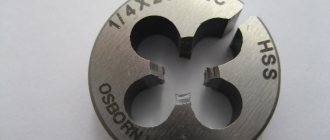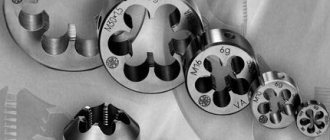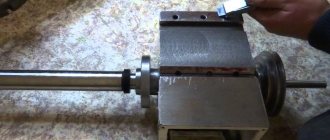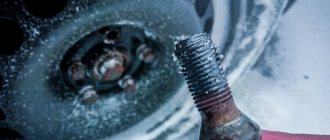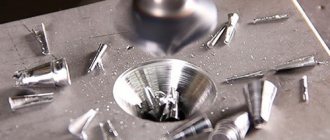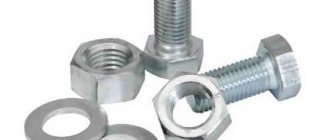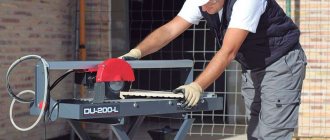Due to their high reliability and simplicity, threaded connections are widely used in various building structures, machines and mechanisms. Since the basic geometric parameters of threads are generally accepted, it is enough to have a small set of standard tools to create new connections and repair worn units.
Internal thread
The internal thread is cut into the hole using taps (1). They are metal rods with hardened teeth. Manufactured from tool or high-speed steel.
Types of taps
Taps are distinguished by purpose. They can be used for cutting metric, inch, tapered, pipe, and trapezoidal threads. According to the relevant technical specifications, as well as GOST 3266-81, the table shows the limits of applicability of this tool.
| Thread name | Nominal diameters |
| Metric | 1 - 52 mm |
| Inch | 1/4” - 2” (inches) |
| Conical | 1/16” — 2” |
| Pipe | 1/16” — 6” |
| Trapezoidal | 5.6 - 90 mm |
Taps for cutting metric and inch threads are manufactured in sets. The set can consist of either two, finishing and roughing, or three - roughing, medium and finishing taps. The roughing tap is designed to remove the bulk of the chips. Finishing is used for the final, precise shaping of the thread profile and calibration.
To identify the tap in the kit, its tail part is marked with one, two or three ring marks. It is also possible to designate using a number: I – rough, II – medium, III – finishing.
Nut taps are designed to cut threads in one pass. They are single-set, that is, sold individually.
To rotate the taps, use knobs (2). They can be non-adjustable with square holes for a fixed size shank, or adjustable. In addition, there are wrenches with a ratchet mechanism, providing ease of work in hard-to-reach places.
How to restore a thread with and without a tap
How to restore a thread with and without a tap
You can restore damaged internal threads with or without a tap in various ways. We will talk about them in detail in this article.
Repairing threads using a spiral insert
Spiral (also called wire and spring) inserts are also often used to restore damaged threads.
Photo: spiral inserts for thread restoration
These devices have high-precision rhombic threaded profiles on the inside. Almost all models are equipped with special driving tongues designed for screwing in devices.
For the manufacture of such products, especially durable high-quality stainless steel is used. This guarantees the resistance of the restored thread to deformation and corrosion.
Restoring threads using a spiral insert includes 4 stages.
Drilling. Drill out the hole. Select the diameter of the cutting tool according to the table that manufacturers provide with spiral inserts.
Image: Drilling out a hole for a spiral insert
Thread formation. Note! To cut threads, use special taps that differ from standard ones and come with spiral inserts. Follow all rules and recommendations.
Image: Forming a thread for a spiral insert
Installation of the device. Place the spiral insert onto the supplied special tool and screw it into the hole.
Image: Screwing the spiral insert into the hole
Removing the drive tongue. You can get rid of it using a special tool (manufacturers also supply it). To remove tabs from large-diameter inserts, ordinary pliers are suitable.
Using professional spiral thread inserts has the following advantages.
The required tension is ensured at the insert landing site. This completely prevents twisting. The devices are located in the receiving threads with virtually no gaps. There is no need to use glue for additional fixation of products.
Due to the elasticity of the inserts, loads and stresses are distributed evenly. This creates ideal conditions for the transfer of forces between the bolts and the receiving threads.
Spiral inserts are universal. They are used not only to restore threads, but also when it is necessary to strengthen connections. Spiral inserts are used when working with products made of low-medium and high-strength metals, as well as plastic and wood.
External thread
The external thread is manually cut into dies (5) and plugs (4). The die is a round nut made of high-speed or high-hardness tool steel. In order to remove chips, special holes are provided in it. The dies are either solid or split.
Split dies have a slot up to 1.5 mm in size. Thanks to this, they allow you to adjust the diameter of the cut thread within 0.1-0.3 mm. Their disadvantage is less accuracy, so using such a tool in critical connections is not recommended. The diameters of the dies are presented in the table.
| Thread name | Nominal diameters |
| Metric | 1 - 76 mm |
| Inch | 1/4” - 2” (inches) |
| Pipe | 1/8” — 2” |
The rotation of the dies is carried out using die holders (3) and ratchets. These devices typically allow multiple cutting tool sizes, such as M16 - M20, 1/2" - 1". Ratchets are used for cutting pipe threads with dies in hard-to-reach places, for example, near a wall.
The dies are designed for cutting external pipe threads with a diameter of 1/2" - 3". Thanks to their design, they are securely fixed to the pipe, which ensures ease of operation, as well as high quality threaded connections. Clupps are usually equipped with replaceable cutters or heads. This significantly increases their service life. Depending on the design, both removable handles and ratchet holders can be used to rotate hand clamps.
Some technical characteristics
To begin with, we note that the type of tool in question can only be used in conjunction with special holders.
This is due to the fact that a lot of force must be transferred to the die during machining. One holder can be used to work simultaneously with different types of lechers. The following information should also be taken into account:
- Left-handed dies are used to produce left-handed threads. Today they are used extremely rarely. To identify the tool, the designation “LH” is applied. Such a thread is required when the element is constantly in rotation during operation.
- Pipe versions differ from metric ones; for identification, the symbol “G” is applied to the surface of the body.
- To obtain a cone thread, a conical pipe tool is used. Most often used on production lines for the production of machine tools or fuel pipelines. Indicated by applying the letter “K” to the surface of the body.
When choosing a tool, you should pay attention to the concept of pitch - the distance formed between two adjacent turns. It is worth considering that the die has a main and additional step
Will need
- Clamp for the required pipe diameter.
- Adjustable wrench (gas).
Klupp is a thread-cutting tool, like a die, only it is an attachment with a guide skirt. It must be purchased from a plumbing store. There is no shortage of them, so you can find them without problems, even in the village.
In this case, the Chinese version is presented, which is quite good.
Such a thing costs around 200-500 rubles. It all depends on the diameter and markup. Running models with diameters of 1/2, 3/4 inches and inch, as in my version.
You can ask plumbers for a Soviet equivalent, if possible. Then it will be completely free for you.
How to restore a thread with a tap
Before restoring a thread with a tap, determine whether it is possible to increase its diameter or cut a new one in a different location. If yes, then the repair will take place very quickly.
Photo: tapping a thread
When working, observe the following basic rules.
Drill the hole strictly at a right angle
Use two new taps of the required diameter (for roughing and finishing).
Be careful when cutting threads. Avoid distortions and sudden movements.
It is advisable to cut the thread using a wrench. If you don't have one, take an adjustable wrench.
Remember to use lubricant and remove chips regularly.
Using Epoxy Glue
This method is not suitable for restoring and strengthening connections subject to high loads and vibrations. There is also no point in using epoxy glue if components and structures operate at high temperatures.
Photo: epoxy glue for thread restoration
If there is no need to ensure high connection reliability, proceed this way.
Welding the hole and then cutting a new thread
This method is rarely used due to the fact that the strength of the new thread obtained using this technology will be lower. This method is also chosen in the absence of special devices (screws and spiral inserts).
READ How to Disassemble a Bosch Gbh 2 24 Rotary Hammer
This method of thread restoration includes the following steps.
Removing old threads by drilling.
Welding the hole. The choice of technologies depends on the materials of the parts.
How to thread a bolt without a tool.
To weld holes in steel products, electric arc or gas welding is used in protective environments.
When working with cast iron parts, gas or electric arc welding is used in a cold state or with general/local heating.
Electrodes (MNCh-1, OZCh-1, TsCh-1), cast iron rods with increased m silicon and other materials are used as additives.
Machining the hole flush with the base metal.
Note! When working with aluminum products, this method of thread restoration is usually not used. This is due to the fact that the metal actively absorbs gases during welding. Pores form in the deposited layers. With severe shrinkage, cracks appear.
Tool selection
Let us note in advance that threads can be cut You can work either manually or by machine. In the first case, as we noted above, you need to have a set of tools with you for creating threads, in the second, the work is carried out on a lathe.
Manual threading is recommended if your task is to machine only a few parts. For example, when assembling plumbing equipment, creating household pipelines, etc.
Processing parts on a lathe involves performing large-scale tasks. A person with experience with this type of equipment is able to cut threads on an industrial scale, up to a hundred parts per hour, and sometimes more. However, you are unlikely to need such performance.
Most often, a set of hand tools covers all the household needs of home craftsmen. With their help, you will also be able to cut threads correctly and efficiently, but it will only take more time and effort.
The set of equipment mentioned above is mainly represented by taps and dies, as well as various additional parts.
Preparatory stage
The quality of the final product depends on how responsibly this stage is completed.
- The tool that will be used to perform the work must be in good condition. There should be no rust on it. For this purpose, during long-term storage it is coated with a preservative lubricant. Clupp cutters must be well sharpened.
- If the pipe has already been in use and there is paint on it, then it must be thoroughly cleaned. This is done with a file, grinder and grinding wheel, sandpaper or hair dryer.
- Using a grinder or hacksaw, the plane of the end is drawn out. To do this, a small piece is cut off to make a right angle relative to the axis.
- The burrs are removed with a file.
- The chamfer is removed in such a way as to create a small cone.
